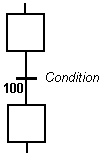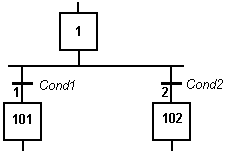SFC Transitions
-
-
To change the number of a step, transition, or jump, select it and press Ctrl+ENTER.
The transition is marked by a small horizontal line that crosses a link drawn between the two steps.

|
|
Transitions define the dynamic behavior of the SFC chart, according to these rules:
- A transition is crossed if:
- Its condition is TRUE and all steps linked to the top of the transition (before) are active.
- When a transition is crossed:
- All steps linked to the top of the transition (before) are deactivated.
- All steps linked to the bottom of the transition (after) are activated.
Divergences
It is possible to link a step to several transitions and create a divergence.
- The divergence is represented by a horizontal line.
- Transitions after the divergence represent several possible changes in the situation of the program.
- All conditions are considered as exclusive, according to a left-to-right priority order.
- It means a transition is considered as FALSE if at least one of the transitions connected to the same divergence on its left side is TRUE.
Example
|
Transition 1 is crossed if:
Transition 2 is crossed if:
|







